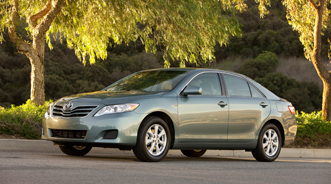Toyota Recalls 7.4M Units Worldwide in Largest Single Campaign Since 1996

By subscribing, you agree to receive communications from Auto Remarketing and our partners in accordance with our Privacy Policy. We may share your information with select partners and sponsors who may contact you about their products and services. You may unsubscribe at any time.
TORRANCE, Calif., and TORONTO –
In what industry analysts believe is the largest single campaign in 16 years, announcements from Toyota Motor Sales USA and Toyota Canada on Wednesday covered more than 2.6 million of the more than 7.4 million vehicles to be recalled worldwide by the Japanese automaker.
OEM officials explained the recall is to inspect and apply special fluorine grease to the driver’s side power window master switch (PWMS).
In the U.S., Toyota indicated the recall involves approximately 2.5 million vehicles, including:
—2007 to 2008 Yaris (approximately 110,300 units)
—2007 to 2009 RAV4 (approximately 336,400 units)
—2007 to 2009 Tundra (approximately 337,100 units)
—2007 to 2009 Camry (approximately 938,100 units)
—2007 to 2009 Camry Hybrid (approximately 116,800 units)
—2008 to 2009 Scion xD (approximately 34,400 units)
—2008 to 2009 Scion xA (approximately 77,500 units)
—2008 to 2009 Sequoia (approximately 38,500 units)
—2008 Highlander (approximately 135,400 units)
—2008 Highlander Hybrid (approximately 23,200 units)
—2009 Corolla (approximately 270,900 units)
—2009 Matrix (approximately 53,800 units)
As for Canada, officials shared the breakdown of the 239,459 vehicles being recalled in that country, including:
—2007 to 2008 Yaris (approximately 46,701 units)
—2007 to 2009 RAV4 (approximately 36,328 units)
—2007 to 2009 Tundra (approximately 21,156 units)
—2007 to 2009 Camry (approximately 46,853 units)
—2007 to 2009 Camry Hybrid (approximately 12,894 units)
—2008 to 2009 Sequoia (approximately 963 units)
—2008 Highlander (approximately 8,283 units)
—2008 Highlander Hybrid (approximately 1,420 units)
—2009 Corolla (approximately 40,646 units)
—2009 Matrix (approximately 24,215)
Subscribe to Auto Remarketing to stay informed and stay ahead.
By subscribing, you agree to receive communications from Auto Remarketing and our partners in accordance with our Privacy Policy. We may share your information with select partners and sponsors who may contact you about their products and services. You may unsubscribe at any time.
Toyota explained the driver’s side PWMS may experience a “notchy” or sticky feel during operation.
“If commercially available lubricants are applied to the switch in an attempt to address the ‘notchy’ or sticky feel, melting of the switch assembly or smoke could occur and lead to a fire under some circumstances,” the automaker cautioned.
“The ‘notchy’ or sticky feel may be caused by an uneven application of the grease during the switch assembly process at the supplier,” Toyota indicated. “If the grease is not applied evenly, frequent use of the switch and normal operation may cause the grease to become carbonized and may eventually result in the deterioration of its lubricating properties.”
The OEM said the recall remedy will involve an inspection, switch disassembly and application of special fluorine grease. Officials added the switch inspection and repair will be performed at no charge to the vehicle owner. They believe the repair will take approximately one hour depending on the dealer’s work schedule.
Toyota went on to mention owners of vehicles covered by this safety recall in both the U.S. and Canada will receive an owner notification letter via first class mail starting in late this month.
“No other Toyota, Lexus or Scion vehicles are involved. We are not aware of any vehicle crashes for this condition,” officials declared.
Detailed information is available to U.S. customers at www.toyota.com/recall and the Toyota Customer Experience Center at (800) 331-4331. Canadian customers can visit www.toyota.ca or call 1-800-TOYOTA-8.
Reaction to Latest Toyota Recall
As Reuters pointed out in this report, Toyota’s campaign is the biggest single recall since Ford pulled 8 million vehicles off the road in 1996 to replace defective ignition switches that could have caused engine fires.
“It may be overwhelming to hear that so many cars have been recalled, but in truth, carmakers save money by using common parts wherever and whenever possible, and this greatly increases the number of affected vehicles when there is a recall,” Edmunds.com senior editor John O’Dell noted.
No matter, Bloomberg calculated in this report that the scale of the recall is equivalent to 93 percent of the vehicles Toyota sold last year and comes as president Akio Toyoda pushes to rebuild the company’s reputation for quality.
Bloomberg reiterated that Toyota recalled more than 10 million units in 2009 and 2010 for defects associated with unintended acceleration and needed two years for its Lexus brand to regain the top spot on J.D. Power & Associates’ new-vehicle quality survey in 2011.
As far as vehicle owners, Edmunds.com features editor Carroll Lachnit advised consumers to stay on top of recalls that affect them.
“Consumers enjoy having a lot of features in their cars, but sometimes things can and will go wrong, and the probability increases with every additional feature you have,” Lachnit conceded. “To keep you and your family safe, it's critical to stay informed about recalls and to address them quickly when they affect your car.”


